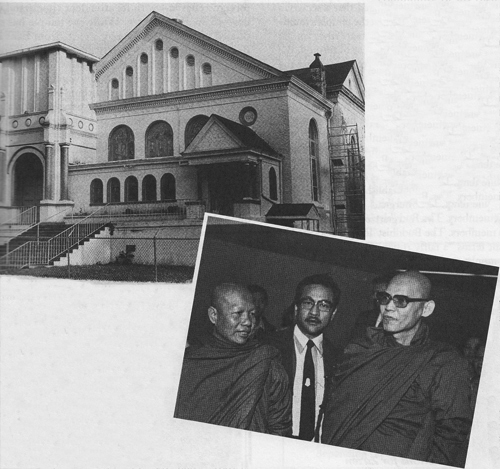
NORTH EDGEFIELD BAPTIST CHURCH stands in a residential neighborhood in Nashville, Tennessee. The church looks much the same as it did when it was first constructed in 1892: stained glass windows, crosses, and other icons of Christian faith still decorate the worship hall. On the altar in front of the old baptismal tank, however, rests a six-foot brass Buddha brought from Thailand-an arresting symbol of new contributions being made to American religious pluralism by ethnic Asian communities.
The church was purchased for $87,000 in 1981 by Dr. U Win Myint, a professor of mathematics at Tennessee State University. Myint came to the United States in 1954 from Burma, earning college and postgraduate degrees in engineering. Although raised in a Theravada Buddhist family, he became an active member in a number of Methodist, Baptist, and Unitarian congregations during his first years in America. Always remaining a “Buddhist in the heart,” Myint explained that the Christian congregations helped alleviate his feelings of alienation from his new surroundings.
The violence and civil conflicts that wracked Southeast Asia in the seventies provided Myint with a community of his own religious heritage. Displaced soldiers and their families-nearly two thousand unskilled and uneducated refugees from Laos, Cambodia, and Vietnam-were resettled in Nashville. To help promote economic self-sufficiency among the refugees, in 1975 Myint founded the International Market, a restaurant that serves authentic Southeast Asian food and provides jobs for many refugees.
Hoping to help provide a source of spiritual guidance as well, Myint embarked on an even more ambitious venture six years later, purchasing the North Edgefield Baptist Church and converting it into Nashville’s first Theravada Buddhist temple. The original goals of The Buddhist Temple were lofty: Myint hoped that monks from Southeast Asia would take up residence in the old church and eventually establish a monastery. More important, he envisioned the temple as an international Asian cultural center with two educational goals: to preserve the integrity of the refugees’Buddhist heritage while providing educational services designed to help them become integrated into American society.
Unforeseen difficulties, however, have challenged Myint and the Nashville temple. In accordance with Myint’s original plan, nearly thirty monks were sent to Nashville by the Sasana Council in Thailand during the early eighties. It soon became apparent, however, that the monks had their own agenda distinct from the dual educational goals of the temple; instead of applying their teachings toward helping the refugee community, the monks sought to transform the temple into a sectarian monastery for members of the Dhammayuttika sect of Theravada Buddhism. Myint believed that a sectarian Thai monastery would compromise the temple’s multicultural and ecumenical charter and create strife among the various refugee groups. After a year of turmoil, the Thai monks were dismissed. “We were afraid that the international nature of the temple would be lost,” Myint explained. “There were hard feelings in the minds of some of the Thai Buddhist monks.”
Additionally, many refugees were at first reluctant to attend the temple for fear of offending their “hosts” -the Refugee Resettlement Agency organized by the Catholic Church. According to Myint, agents from the resettlement organization visited the homes of refugee families shortly after the temple was established, warning them against attending services there.
Recently, the temple was burglarized, prompting fear among its members. The Buddhist Temple is located in what Myint terms “a fairly rough neighborhood,” and the new monks and lay practitioners have become increasingly apprehensive about their safety. Myint plans to move The Buddhist Temple to a Nashville suburb, closer to the homes of the refugees. “Our efforts will be more successful in the future,” he says optimistically. “We’ll be able to do a much better job for the refugees once we have moved into a new building.” It remains to be seen, however, if the challenges confronting Myint are the result of the center’s poor geographical location or the product of deeper cultural divisions among the various refugee groups in the community.
Myint’s struggles at The Buddhist Temple highlight an important tension in contemporary American religious life: the difficulties inherent in transplanting a foreign religion-with its attendent rituals and values-to another culture. While the temple has succeeded in attracting two new monks from Laos and Burma and developing weekly dharma talks, meditation groups, prison outreach programs, and lectures at local Vanderbilt University, fundamental problems remain. Perhaps the most disturbing challenge-one that strikes at the very heart of the temple’s cultural and religious mission-lies with the youth of the refugee community: many second-generation refugee children have abandoned their Buddhist heritage, opting instead to immerse themselves in popular American lifestyles. “Older people have maintained their strict Buddhist culture,” Myint asserts, “but the majority of the new generation are drifting away. They do not even think about religion. They do not become Christians, they do not become devout Buddhists. They want to have shiny cars and listen to nice music.”–Douglas Winiarski
Thank you for subscribing to Tricycle! As a nonprofit, we depend on readers like you to keep Buddhist teachings and practices widely available.